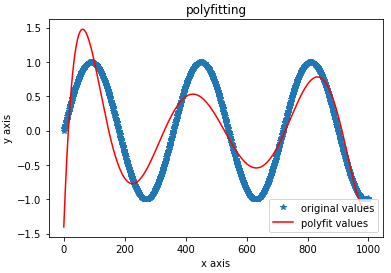python多项式拟合:np.polyfit 和 np.polyld
python数据拟合主要可采用numpy库,库的安装可直接用pip install numpy等。
1. 原始数据:假如要拟合的数据yyy来自sin函数,np.sin
import numpy as np import matplotlib.pyplot as plt
xxx = np.arange(0, 1000) # x值,此时表示弧度 yyy = np.sin(xxx*np.pi/180) #函数值,转化成度
2. 测试不同阶的多项式,例如7阶多项式拟合,使用np.polyfit拟合,np.polyld得到多项式系数
z1 = np.polyfit(xxx, yyy, 7) # 用7次多项式拟合,可改变多项式阶数; p1 = np.poly1d(z1) #得到多项式系数,按照阶数从高到低排列 print(p1) #显示多项式

3. 求对应xxx的各项拟合函数值
yvals=p1(xxx) # 可直接使用yvals=np.polyval(z1,xxx)
4. 绘图如下
plt.plot(xxx, yyy, '*',label='original values') plt.plot(xxx, yvals, 'r',label='polyfit values') plt.xlabel('x axis') plt.ylabel('y axis') plt.legend(loc=4) # 指定legend在图中的位置,类似象限的位置 plt.title('polyfitting') plt.show()

5. np.polyfit函数:采用的是最小二次拟合,numpy.polyfit(x, y, deg, rcond=None, full=False, w=None, cov=False),前三个参数是必须的
官方文档:https://docs.scipy.org/doc/numpy-1.13.0/reference/generated/numpy.polyfit.html
6. np.polyld函数:得到多项式系数,主要有三个参数
A one-dimensional polynomial class. A convenience class, used to encapsulate "natural" operations on polynomials so that said operations may take on their customary form in code (see Examples). Parameters ---------- c_or_r : array_like The polynomial's coefficients, in decreasing powers, or if the value of the second parameter is True, the polynomial's roots (values where the polynomial evaluates to 0). For example, ``poly1d([1, 2, 3])`` returns an object that represents :math:`x^2 + 2x + 3`, whereas ``poly1d([1, 2, 3], True)`` returns one that represents :math:`(x-1)(x-2)(x-3) = x^3 - 6x^2 + 11x -6`. r : bool, optional If True, `c_or_r` specifies the polynomial's roots; the default is False. variable : str, optional Changes the variable used when printing `p` from `x` to `variable` (see Examples).
参数1表示:在没有参数2(也就是参数2默认False时),参数1是一个数组形式,且表示从高到低的多项式系数项,例如参数1为[4,5,6]表示:

参数2表示:为True时,表示将参数1中的参数作为根来形成多项式,即参数1为[4,5,6]时表示:(x-4)(x-5)(x-6)=0,也就是:

参数3表示:换参数标识,用惯了x,可以用 t,s之类的
用法:
1. 直接进行运算,例如多项式的平方,分别得到
xx=np.poly1d([1,2,3]) print(xx) yy=xx**2 #求平方,或者用 xx * xx print(yy)


2. 求值:
yy(1) = 36
3. 求根:即等式为0时的未知数值
yy.r
4. 得到系数形成数组:
yy.c 为:array([ 1, 4, 10, 12, 9])
5. 返回最高次幂数:
yy.order = 4
6. 返回系数:
yy[0] —— 表示幂为0的系数
yy[1] —— 表示幂为1的系数
参考:
https://www.cnblogs.com/zhouzhe-blog/p/9621679.html




 浙公网安备 33010602011771号
浙公网安备 33010602011771号